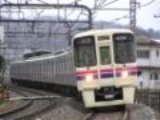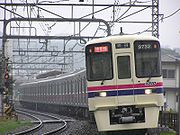
Keio 9000 series
Encyclopedia
The is an electric multiple unit
operated by Keiō Corporation on the Keiō Line and its branches in Tōkyō
and Kanagawa
, Japan
.
From May 2005, a new version compatible with Toei Shinjuku Line
equipment, the '30' subseries, was introduced as 10-car formations.

 The front end design is based on the design of the Keiō 5000 series
The front end design is based on the design of the Keiō 5000 series
. The body is stainless steel and manufactured with the Nippon Sharyo
's unique "block structure" system. Some sets were built at Tokyu Car Corporation
, but body structures are the same as the Nippon Sharyo sets. The front portion is steel painted in ivory white.
.
'0 series' sets are mainly used on Local and Rapid services during daytime. They are also used on 10-car Semi Special Express trains. To create a 10-car train, two Keiō 6000 series
cars are added to an eight-car 9000-series train.
and the Toei Shinjuku Line
via the inner end of the Keiō Line. 30-series sets are rarely used on the section west of Chōfu Station
on the Keiō Line.
Electric multiple unit
An electric multiple unit or EMU is a multiple unit train consisting of self-propelled carriages, using electricity as the motive power. An EMU requires no separate locomotive, as electric traction motors are incorporated within one or a number of the carriages...
operated by Keiō Corporation on the Keiō Line and its branches in Tōkyō
Tokyo
, ; officially , is one of the 47 prefectures of Japan. Tokyo is the capital of Japan, the center of the Greater Tokyo Area, and the largest metropolitan area of Japan. It is the seat of the Japanese government and the Imperial Palace, and the home of the Japanese Imperial Family...
and Kanagawa
Kanagawa Prefecture
is a prefecture located in the southern Kantō region of Japan. The capital is Yokohama. Kanagawa is part of the Greater Tokyo Area.-History:The prefecture has some archaeological sites going back to the Jōmon period...
, Japan
Japan
Japan is an island nation in East Asia. Located in the Pacific Ocean, it lies to the east of the Sea of Japan, China, North Korea, South Korea and Russia, stretching from the Sea of Okhotsk in the north to the East China Sea and Taiwan in the south...
.
History
The first 9000 series entered service in January 2001. The original eight sets of the '0' subseries were formed as eight-car sets (numbered 9701 to 9708).- Built in fiscal 2000: 9701, 9702
- Built in fiscal 2001: 9703, 9704, 9705
- Built in fiscal 2002: 9706
- Built in fiscal 2003: 9707
- Built in fiscal 2004: 9708
From May 2005, a new version compatible with Toei Shinjuku Line
Toei Shinjuku Line
The is a subway line in Tokyo and Chiba Prefecture, Japan, operated by Tokyo Metropolitan Bureau of Transportation . The line runs between Motoyawata Station in Ichikawa, Chiba in the east and Shinjuku Station in the west...
equipment, the '30' subseries, was introduced as 10-car formations.
- Built in fiscal 2005: 9731, 9732
- Built in fiscal 2006: 9733, 9734, 9735
- Built in fiscal 2007: 9736, 9737, 9738
- Built in fiscal 2008: 9739, 9740, 9741 (as of June 2008)
Additional technical details
- MT ratio
- 0 series: 4M4T (four motor cars and four trailers; each motor car has four motors)
- 30 series: 5M5T
- Gear ratio: 6.07
- Drive mechanism: Parallel cardan shaft
- Headlights: Sealed beam
- Destination indicators:
- 0 series: 3-color light-emitting diodeLight-emitting diodeA light-emitting diode is a semiconductor light source. LEDs are used as indicator lamps in many devices and are increasingly used for other lighting...
(LED) - 30 series: Full-color LED
- 0 series: 3-color light-emitting diode
- Passenger information displays:
- 0 series: 3-color LED (4 per car)
- 30 series (first 5 sets): 3-color LED (4 per car)
- 30 series (9036F and later): Full-color LCD (8 per car)
- Doors per side: 4
Body


Keio 5000 series
The is an EMU which formerly operated on the Keio Corporation, first introduced in 1963. Built in batches by Nippon Sharyo, Tokyu Car Corp and Hitachi, it was the recipient of the 4th Laurel Prize of the Japan Railfan Club....
. The body is stainless steel and manufactured with the Nippon Sharyo
Nippon Sharyo
, , formed in 1896, is a major rolling stock manufacturer based in Nagoya, Japan. In 1996, it abbreviated its name to "日本車両" Nippon Sharyō. Its shortest abbreviation is Nissha "日車". It was a listed company on Nikkei 225 until 2004. It is listed on the Tokyo Stock Exchange and Nagoya Stock Exchange...
's unique "block structure" system. Some sets were built at Tokyu Car Corporation
Tokyu Car Corporation
is a manufacturer of heavy rail cars in Japan. The company is based in Kanazawa Ward, Yokohama, Japan, and a member of Tokyu Group. Tokyu Car manufactures rail vehicles not only for Tokyu Corporation but for other Japanese operators, including various Japan Railways Group companies and...
, but body structures are the same as the Nippon Sharyo sets. The front portion is steel painted in ivory white.
Driver's cab
The master controller is one-handle type with a T-shape handle. The speedometer is analog and can indicate up to 140 km/h. A train navigation system (TNS) is installed.- Acceleration: 4 notches
- Deceleration: 7 notches + emergency
0 series
Although it can be used on all 1,372 mm gauge lines of Keiō, it is mainly used on the Keiō Line, the Takao Line and the Sagamihara LineKeio Sagamihara Line
The is a Japanese railway line operated by Keio Corporation, connecting Hashimoto Station in Sagamihara, Kanagawa Prefecture and Chōfu Station in Chōfu, Tokyo.-History:...
.
'0 series' sets are mainly used on Local and Rapid services during daytime. They are also used on 10-car Semi Special Express trains. To create a 10-car train, two Keiō 6000 series
Keio 6000 series
The was an electric multiple unit operated by Keiō Corporation on its suburban Tokyo commuter rail network between 1972 and 2011. It was the first rolling stock in Keio's history to be 20 meters long with four doors per car side. Sets were refurbished from 1986 to extend their service life.Two...
cars are added to an eight-car 9000-series train.
30 series
'30 series' sets are mainly used for through express services connecting the Keiō Sagamihara LineKeio Sagamihara Line
The is a Japanese railway line operated by Keio Corporation, connecting Hashimoto Station in Sagamihara, Kanagawa Prefecture and Chōfu Station in Chōfu, Tokyo.-History:...
and the Toei Shinjuku Line
Toei Shinjuku Line
The is a subway line in Tokyo and Chiba Prefecture, Japan, operated by Tokyo Metropolitan Bureau of Transportation . The line runs between Motoyawata Station in Ichikawa, Chiba in the east and Shinjuku Station in the west...
via the inner end of the Keiō Line. 30-series sets are rarely used on the section west of Chōfu Station
Chofu Station
Chōfu Station is the name of multiple train stations in Japan.* Chōfu Station - in Tokyo* Chōfu Station - in Yamaguchi Prefecture...
on the Keiō Line.

